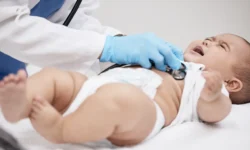Was your baby injured after being in the wrong position during delivery? Learn when a birth injury caused by fetal malposition may be medical malpractice.
Bringing a new life into the world is a beautiful and rewarding experience, but it can also be a complex and challenging process. When a baby is not in the correct birthing position, it can increase the risk of complications during delivery.
Regardless of what position your baby was in before birth, doctors and other medical professionals are required to follow an established standard of care to ensure the safety of you and your baby during delivery. If they failed to follow those standards and your baby suffered a birth injury as a result of their negligence, you may be entitled to compensation through a birth injury lawsuit.
What is a cephalic presentation?
Cephalic presentation is a term used to describe the position of a baby right before delivery in which its head is pointed down towards the birth canal. This is the most common and ideal position for a baby to be in during delivery, as it allows for the safest passage through the birth canal.
In a cephalic presentation, the baby’s head is typically engaged in the pelvis, with the back of the head positioned towards the mother’s pubic bone. This position allows the baby’s head to apply pressure to the cervix, which helps it dilate and ultimately allows for a vaginal delivery.
Cephalic presentation is typically confirmed through ultrasound examination, pelvic examination or by monitoring the baby’s heart rate during labor.
What is fetal malposition?
When a baby is in fetal malposition, it means that they’re not in the proper position for birth.
Examples of fetal malposition include the following:
- Occiput posterior position. This position occurs when the baby’s head is down, but they’re facing the mother’s chest instead of her back. The occiput posterior position can cause problems with the birth as it can slow or stop the baby’s ability to travel down the birth canal.
- Transverse position (abnormal lie). This position occurs when the baby is in a sideways position or the shoulders or back are positioned over the mother’s cervix instead of the head. It can lead to issues such as uterine rupture and fetal distress.
What’s the difference between fetal malposition and fetal malpresentation?
Fetal malposition refers to the baby being in an improper position before delivery. Fetal malpresentation, on the other hand, refers to when the wrong body part is engaged in the birth canal during delivery.
The following are examples of fetal malpresentation during labor:
- Breech position. This is the most common type of fetal malpresentation. The breech position means that the baby’s feet are engaged in the cervix instead of the head. If not corrected during childbirth, it can result in a feet-first delivery.
- Transverse/oblique lie. This position occurs when the baby’s side or shoulder, instead of its head, is engaged in the cervix.
- Face or brow presentation. This position occurs if the baby’s head is extended so that during birth, the face, brow or neck presents first instead of the top of the head.
- Compound presentation. With this position, the baby’s hand or foot is next to the head or buttocks in the cervix.
Usually, a doctor discovers fetal malposition with an ultrasound during a prenatal exam. If the baby’s position is not corrected before birth, the doctor may have to use forceps or vacuum extraction to help pull the baby from the birth canal. In some cases, the mother may need an emergency cesarean section (C-section).
When should a baby move into the correct position prior to birth?
The baby should move into the correct position in preparation for childbirth by the 3rd trimester. Normally, this happens anywhere between the 32nd and 36th week of pregnancy. Doctors are supposed to check the position of the fetus during regular prenatal exams. The doctor can do this by feeling the mother’s stomach or by ordering an ultrasound to look at the baby’s position.
How is fetal malposition or malpresentation diagnosed?
The best way for women to avoid labor complications and have healthy babies is for fetal malposition or malpresentation to be diagnosed as early as possible. Doctors should be able to detect fetal malposition during an abdominal or vaginal exam during a routine prenatal visit. If they suspect fetal malposition, they should confirm this diagnosis with an ultrasound.
What can a doctor do to change a baby’s position before delivery?
Doctors can perform a procedure known as an external cephalic version (ECV) to change a baby’s position before delivery. The procedure is non-invasive, meaning it doesn’t require any cuts or incisions. During an ECV, a doctor applies pressure to the mother’s abdomen to manually turn the baby into a head-down position.
ECV is typically performed after 37 weeks of pregnancy under careful monitoring to ensure the safety of the mother and the baby. The procedure can be uncomfortable for the mother but is generally considered safe and effective in repositioning the baby.
What complications can arise from fetal malposition?
Fetal malposition can lead to a prolonged labor that requires the use of forceps, a vacuum extractor or a C-section. When doctors use assistive devices such as forceps or vacuum extractors to deliver a baby, complications can occur, and a baby can suffer any of the following:
- Nerve damage leading to conditions like Erb’s palsy
- Fractures
- Brain damage
- Cerebral palsy
When is a birth injury that results from fetal malposition considered medical malpractice?
A birth injury that results from fetal malposition may be considered medical malpractice if the doctor or other medical staff fails to take appropriate action to address the malposition, leading to injury or harm to the mother or the baby.
In the case of fetal malposition, OB-GYN negligence may have occurred if the doctor failed to properly diagnose or manage the malposition, failed to perform a timely C-section when necessary, or used excessive force or inappropriate techniques or instruments during delivery.
It’s important to note, however, that not all birth injuries that result from fetal malposition are due to medical malpractice. Sometimes, despite the best efforts of healthcare providers, injuries can occur during the birth process. A thorough investigation of the circumstances surrounding the injury is necessary to determine if medical malpractice played a role.
Explore the distinction between birth injuries and defects. Understand their causes, implications, and how they influence a child’s health and development.
Consult a birth injury attorney
Birth injuries can lead to serious health consequences that require costly, life-long treatment and rehabilitation. If you believe your child suffered a birth injury because of a doctor’s medical negligence, you owe it to yourself and your child to get the compensation they need to live their life to the fullest.
If you have questions about the birth injury lawsuit process or want help filing your claim, contact attorney Laura Brown at Brown Trial Firm. Laura has years of experience in birth injury law, helping families like yours all across the U.S. get the compensation they deserve.
Contact her today for a free consultation of your case.
- Cerebral Palsy
- Caput Succedaneum and Cephalohematoma
- Neonatal Intracranial Hemorrhage (Childbirth Brain Bleeds)
- Hydrocephalus (Extra Fluid in the Brain Cavity)
- Cervical Dystonia
- Hemiplegia (Brain or Spinal Cord Injury)
- Hemorrhagic Stroke
- Neonatal Stroke
- HIE
- Periventricular Leukomalacia (PVL) Brain Injury
- Infant Seizures
- Spastic Diplegia (Spasticity in the Legs)
- Top Risks for Birth Injuries
- Fetal Alcohol Syndrome
- Facial Paralysis
- Spinal Cord Injuries
- Bell’s Palsy
- Brachial Plexus Nerves & Erb’s Palsy
- Klumpke’s Palsy
- G-Tubes for Newborns
- Medical Errors
- Cesarean Section & Birth Injury
- Negligence in Brain Cooling Treatment
- Craniosacral Therapy
- Occupational Therapy
- Speech Therapy
- Transition From Pediatric to Adult Healthcare
- Surgical Options for Spastic Cerebral Palsy
- Fetal Intolerance to Labor
- Jaundice (Kernicterus)
- Breech Position
- Placental Complications
- Umbilical Cord Problems
- Uterine Rupture
- Cervical Incompetence (Insufficiency)
- Blighted Ovum
- Necrotizing Enterocolitis (NEC) - Intestinal Inflammation
- Cephalopelvic Disproportion
- Meconium Aspiration Syndrome
- Amniotic Fluid Embolism
- Birth Injury from Premature Delivery
- Developmental Delays
- Abnormal Cord Insertion
- Infections at Birth
- Chorioamnionitis Bacterial Infection
- Premature birth
- Oxygen Deprivation
- Listeria
- Birth-Acquired Herpes
- Placenta Previa
- Placental Abruption
- Mismanaged Fetal Malposition
- Rapid Labor
- Obesity Related Birth Injuries
- Intrauterine Growth Restriction
- Blood Clots During Pregnancy
- Ectopic Pregnancy Misdiagnosis
- Myths & Facts About Birth Injuries
- Bacterial Vaginosis
- Gestational Diabetes
- Maternal Mortality Risk
- Oligohydramnios (Low Amniotic Fluid)
- Infections During Pregnancy
- Excessive Bleeding During Pregnancy
- Congenital Syphilis



